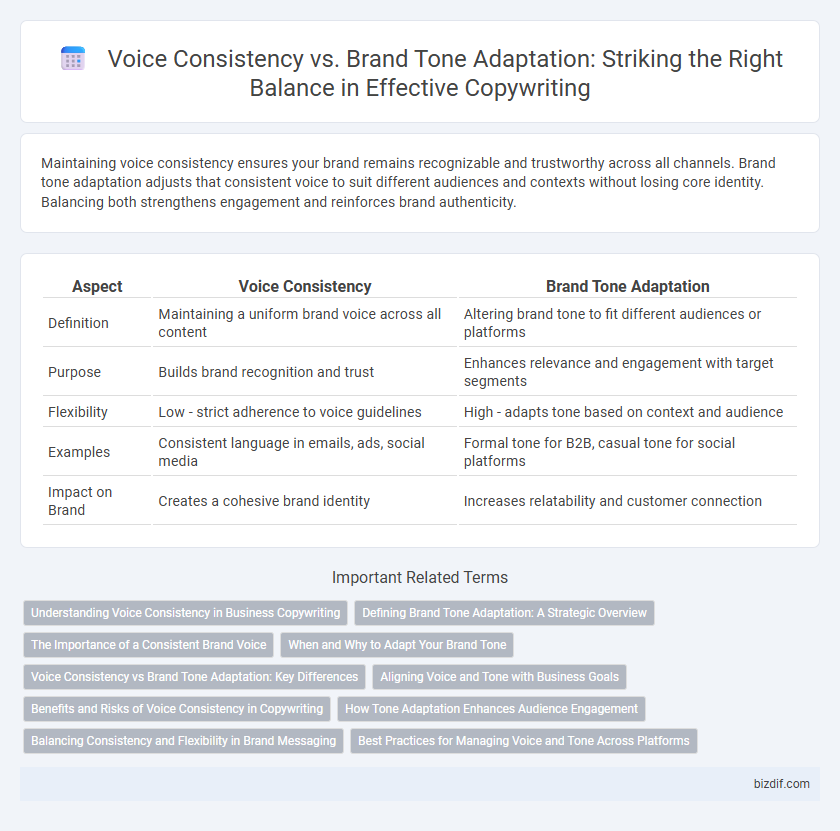Maintaining voice consistency ensures your brand remains recognizable and trustworthy across all channels. Brand tone adaptation adjusts that consistent voice to suit different audiences and contexts without losing core identity. Balancing both strengthens engagement and reinforces brand authenticity.
Table of Comparison
| Aspect | Voice Consistency | Brand Tone Adaptation |
|---|---|---|
| Definition | Maintaining a uniform brand voice across all content | Altering brand tone to fit different audiences or platforms |
| Purpose | Builds brand recognition and trust | Enhances relevance and engagement with target segments |
| Flexibility | Low - strict adherence to voice guidelines | High - adapts tone based on context and audience |
| Examples | Consistent language in emails, ads, social media | Formal tone for B2B, casual tone for social platforms |
| Impact on Brand | Creates a cohesive brand identity | Increases relatability and customer connection |
Understanding Voice Consistency in Business Copywriting
Voice consistency in business copywriting ensures that a brand's messaging remains recognizable and trustworthy across all platforms, enhancing customer loyalty and brand recall. Maintaining a uniform voice helps convey the brand's core values clearly, fostering strong emotional connections with the target audience. This consistency supports cohesive storytelling, making campaigns more effective and reinforcing the brand's identity in a competitive market.
Defining Brand Tone Adaptation: A Strategic Overview
Brand tone adaptation involves strategically modifying a brand's voice to resonate with diverse target audiences while maintaining core brand values. This approach ensures messaging aligns with specific platforms, cultural contexts, and customer expectations, enhancing engagement and relevance. Successful brand tone adaptation balances consistency with flexibility to strengthen brand identity across various market segments.
The Importance of a Consistent Brand Voice
Maintaining a consistent brand voice ensures clear communication and strengthens brand recognition across all customer touchpoints. Consistency in style, vocabulary, and messaging builds trust and fosters emotional connections with the audience. Adapting the brand tone without losing the core voice allows flexibility while preserving the brand's identity and credibility.
When and Why to Adapt Your Brand Tone
Adapting your brand tone is crucial when targeting diverse audience segments or entering new markets to ensure relevancy and engagement. While voice consistency maintains recognizability, tone adaptation allows your message to resonate emotionally by reflecting cultural nuances, platform specifics, and customer preferences. Strategic tone shifts enhance brand authenticity and drive higher conversion rates by aligning communication style with audience expectations.
Voice Consistency vs Brand Tone Adaptation: Key Differences
Voice consistency ensures a brand's core personality remains uniform across all content, creating trust and recognition among audiences. Brand tone adaptation adjusts the emotional inflection and style of communication depending on the platform, audience, or context, enhancing relevance and engagement. The key difference lies in voice being the stable foundation, while tone is a flexible tool tailored to specific marketing needs.
Aligning Voice and Tone with Business Goals
Maintaining voice consistency ensures brand recognition and trust, while adapting tone allows communication to resonate with diverse target audiences and specific campaign objectives. Aligning voice and tone with business goals enhances message clarity, strengthens customer relationships, and drives engagement through tailored yet coherent brand expression. Effective copywriting balances a stable brand voice with flexible tone adjustments to meet strategic marketing outcomes.
Benefits and Risks of Voice Consistency in Copywriting
Voice consistency in copywriting builds trust and strengthens brand recognition by delivering a uniform message across all platforms, ensuring that the audience easily identifies the brand. It minimizes confusion and enhances professional credibility, which can lead to increased customer loyalty and engagement. However, rigid voice consistency risks alienating diverse target segments if it fails to adapt to varying contexts or cultural nuances, potentially limiting the brand's appeal and effectiveness in dynamic markets.
How Tone Adaptation Enhances Audience Engagement
Tone adaptation enhances audience engagement by tailoring brand messaging to resonate with diverse demographic segments, ensuring relevance across communication channels. By adjusting language style, formality, and emotional intensity, brands maintain voice consistency while appealing to specific audience preferences and expectations. This strategic balance fosters deeper connections, increases message retention, and drives higher conversion rates in targeted campaigns.
Balancing Consistency and Flexibility in Brand Messaging
Balancing voice consistency and brand tone adaptation ensures a cohesive yet dynamic brand identity that resonates across diverse platforms and audiences. Maintaining core brand values and linguistic style fosters trust and recognition, while flexible tone adjustments address varying customer emotions and contexts effectively. This strategic equilibrium strengthens brand messaging by combining reliability with responsiveness, enhancing overall engagement and loyalty.
Best Practices for Managing Voice and Tone Across Platforms
Maintaining voice consistency across platforms ensures brand recognition, while adapting tone to fit the audience and channel enhances engagement. Best practices include establishing clear brand voice guidelines, training copywriters on audience-specific nuances, and regularly auditing content for alignment. Leveraging analytics to monitor tone effectiveness enables continuous refinement, balancing uniformity with platform-specific adaptation.
Voice Consistency vs Brand Tone Adaptation Infographic

 bizdif.com
bizdif.com